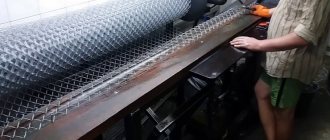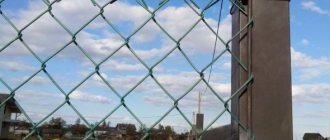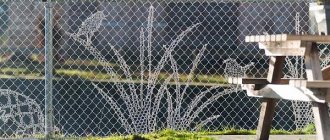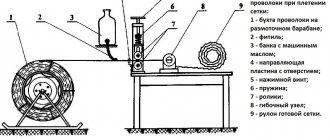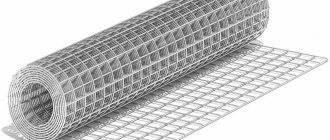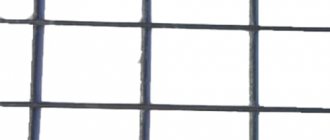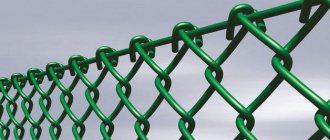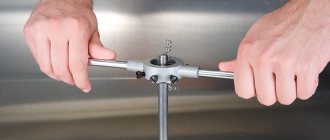Before attaching the chain-link mesh to the profile pipe, the pillars must be prepared. Why do they need to be cleaned of rust, if it appears, painted with a spray or brush. But most importantly, before attaching the chain-link mesh to metal posts, you need to weld hooks to fix the mesh material (considered the best option for tension fencing). If this option is not available, fastening to the corrugated pipe can be done with clamps, staples or wire.
How to attach a mesh metal sheet without welding
Galvanized mesh for fences
Fences made from mesh are very popular; they are indispensable in cases where you need a reliable fence with good light transmission and a low price. In addition, modern fences made of welded galvanized mesh are very attractive, durable and easy to install with your own hands.
Classic country fence made of galvanized welded mesh
Fastening the chain-link to the poles
Tools and accessories:
Electric welding is the most reliable connection between mesh and supports.
- Shovel;
- Scrap;
- Welding machine;
- Electric drill with a set of drills;
- Electric screwdriver;
- Devices for tensioning the mesh on a pole;
- Nails 70-100 mm (2 kg);
- Screws 70-100 mm (1.5 kg);
- Wire rod 6-8 mm (taking into account approximate measurements);
- Steel bar (reinforcement) with a diameter of 10 mm and hooks for fixing the mesh.
Options for installing a fence using the tension method:
- Stretch fence without pulling wire or reinforcement;
- Pull fence with the passage of one bar of steel reinforcement (wire, cable);
- Fence by tension method with pulling two rods of reinforcement (cable, wire).
We begin the work with a corner post using proven technology. To avoid sagging, we stretch a steel cable or reinforcement with a mesh attached to it. Raise the mesh 10 cm above the ground.
Instead of corner frames, wooden frames can be used.
Remember that the installation of galvanized wire mesh begins with a corner post. Two people lift the chain link and straighten it along the post. Using nails and screws, the mesh is pre-attached to the support and then securely fixed with a bracket. Next, using uniform tension, the chain-link is attached to the next post and is also fixed with staples. It is necessary to monitor the tension over the entire area of the material cells. The distortion will subsequently be impossible to correct. After securing, a cable is passed around the entire perimeter to prevent the surface of the mesh spans from tilting in one direction or another.
Advantages of galvanized mesh
They produce galvanized mesh from metal wire. Its rods are arranged perpendicularly and are fastened at the connection points by welding. The cells of the welded mesh are made rectangular, square, less often diamond-shaped, trapezoidal or other shapes.
The wire for the mesh is galvanized or with an additional polymer coating. Fencing made of welded galvanized mesh has its advantages:
- Affordable price;
- Simple and quick installation of the mesh can be done with your own hands;
- Light weight, does not require foundation construction;
- Transparency and good visibility allow it to be used at protected sites;
Fence design made of galvanized mesh and metal corners
Types of chain link
Even an ordinary chain-link can be of various types. At the same time, the difference is significant both in cost and in duration of operation. Let us note the features of some types:
- Non-galvanized. A low-cost and short-lived product that requires large expenses to maintain the fence in good condition. Immediately after installation, the material must be painted, this way you can avoid corrosion processes. Painting is done every year.
- Galvanized. More expensive in price, but does not require painting and lasts a long time.
- PVC mesh. There is a layer of plastic on the steel wire. This type of material appeared relatively recently. The price is more expensive, but the appearance is beautiful and the service life is longer. When choosing, you need to pay attention to the rigidity and cross-section of the wire located under the polymer. Good quality wire is difficult to bend by hand. If it bends, it will be difficult to attach and tighten in the future.
- Polymer. Made from polymer with additives that increase resistance to sunlight. It can be painted in different colors and is made with different cell sections. There are classic ones, reminiscent of simple chain-link cells, oblong and even round sections. Often this type of mesh is also called a plastic fence. It can be used for a neighbor's border. This product is not suitable as a fence from the street because it is fragile.
After installation
In addition to the different material, the mesh differs in the diameter of the cells, which can be 20–75 mm. The higher this size, the cheaper the material, but also the lower the strength. If you attach a chain-link fence to a corrugated pipe on the neighbor's border, use a section of 45–65 mm.
When choosing a mesh, you need to carefully look at all the rolls. Their edges must be of the correct shape. The length of the cell must have a bent part greater than 50% of the length of the link. This chain link is easier to properly attach to the post in the opening.
You should also pay attention to the cross-section of the wire, the evenness of the links, how well they fit on the corrugated pipe. Any deformation is a sign of poor quality.
Profile support
If the mesh has a polymer layer, it is necessary to clarify the warranty period. Budget ones, in addition to inappropriate quality, use cheap plastic, which crumbles after a year when exposed to sunlight. Good coating and proper installation will provide the professional pipe with a service life of up to 30 years, so you should not skimp.
Types of welded mesh fences
Depending on the type of coating, welded mesh fencing is available in the following types:
- Non-galvanized mesh. The simplest version of a mesh welded from steel wire with a diameter of 1.2–10 mm. It has a low price and is susceptible to corrosion.
- This mesh will have to be painted periodically to improve its appearance and provide additional protection.
Rolls of non-galvanized mesh size 50x50 Also, galvanized mesh can be produced in the following types:
Drawing of a section of a fence made of galvanized mesh
- Galvanized mesh in rolls. The weight of the roll can be from 50 to 500 kg. The height of a fence made of rolled mesh is available up to two meters. The length of the mesh in the package can be from 15 to 33 m.
- Sectional (quick-release) fence mesh. Such a fence can be assembled very quickly with your own hands. The welded mesh is placed in a rectangular frame made of a profile pipe or angle. A fence made of sections is more durable and attractive. Sectional fencing is the most in demand both in urban environments and in the private sector.
- Decorative welded mesh 3D for fences. A new type of galvanized fence made of welded sections. How to attach a gate to a brick pillar? The design is made of curved rods that create a three-dimensional effect; it looks very unusual and beautiful. This version of the fence uses a PVC layer and decorative wavy sections along the edges or in the middle of the canvas. Another option is made in the form of twisted and corrugated wires.
Decorative fencing made of welded mesh can often be seen around city parks; it looks organic in combination with the vegetation around playgrounds and private cottages.
Return to contents
The main stages of building a fence
A fence made of welded mesh is built using the following materials: sections of fence cloth; metal pillars with embedded parts, but they can be secured with your own hands using a welding machine; concrete solution.
Scheme of sectional fencing made of welded mesh
Basic tools: welding machine, screwdriver (if the sections will be attached to the poles using a threaded connection), tape measure, building level, shovel/hand drill.
Step 1:Marking work
A fence made of welded mesh, like any other fencing, requires preparatory work: cleaning the area, checking the difference in soil surface levels, marking.
The construction of the fence begins with markings. To create the desired line, pegs, rope and tape are used.
First of all, you should outline the location of the fence. To do this, drive stakes into the corners with your own hands, and string a rope between them. Next, you need to determine the location of the fence posts. They are placed at a distance that is 15-20 cm greater than the length of the section. The reserve is allocated for the embedded parts with which the fence is attached.
Step 2: Installation of support posts
A fence made of welded mesh is usually erected using metal posts. They are strong enough to support the structure of a section made of frame and mesh. In addition, in most cases, the fence is fastened by welding. Another nuance: a metal fence lasts much longer. And if the wooden posts fail, you will have to repair the fence ahead of time.
To prepare cement mortar, one part cement, one part water and three parts sand are used.
A sufficient cross-section of pillars for a sheet of wire 3-5 mm thick is 60x60 mm. The depth of the holes for the support posts is determined based on data on the structure of the soil and the depth of its freezing. On average, a columnar foundation 0.8-1 m deep is installed for a mesh fence.
It is important that the support is recessed to a level equal to a third of its length. The holes are dug with a shovel, but you can use a hand drill. This will speed up the work. The diameter of the holes in the soil should be several centimeters larger than the posts.
Welded mesh fences are most often installed by completely concreting the supports. This will further strengthen the structure. To make the solution, sand and cement (3:1) are used. Then the hole is filled with cement mixture with your own hands, a pillar is installed there and leveled. Spacers are used to secure the support. After a few days, you can continue building the fence.
Step 3: Attaching the fence cloth
The use of rolled mesh requires the use of special clamps or brackets. In this case, a continuous fence sheet is attached. If you plan to use a more durable mesh, prepare a frame made from a corner or profile pipe.
Each post is equipped with 4 fastening elements that secure the mesh.
The base material is welded to it with your own hands. The finished section is attached to the embedded parts using a welding machine or using a threaded connection method (bolts, nuts).
How to choose a galvanized welded mesh fence
- The first thing you need to pay attention to is the wire thickness and dimensions. The larger the diameter of the rod and the smaller the mesh, the stiffer the structure of the galvanized fence will be. Such a fence will have a higher price, because more material is spent on the mesh;
- Choice of canvas sizes. Depending on the desired height of the fence, you can select a galvanized mesh from 0.5 to 2 m, the length of the mesh in a roll is from 15 to 33 m. Dimensions of the mesh fence section: height - 2 m, length - up to 2.5 m;
- The ends of the wire should have an even cut or bend. There should be no cracks or damage. A mesh produced in violation of technology is unlikely to last long;
- The cells must have the correct symmetrical shape, and the dimensions must correspond to the parameters declared by the manufacturer;
- Polymer-coated mesh should not have any damage to the protective layer; you should especially carefully inspect the bends if you purchase the mesh in a roll.
Pros of mesh fences
Chain-link mesh is popular in the building materials market and has established itself as an affordable and easy-to-install material.
Fence on a summer cottage
Advantages of metal mesh fencing:
- Every person who is not involved in construction will be able to install this iron fence;
- can be purchased at a relatively low price, and in the Leroy Merlin chain of stores delivery is made free of charge to the site, taking into account the order estimate;
- air circulation throughout the entire territory;
- mesh fences are characterized by good quality and long service life, taking more than 30 years;
- the fence fits perfectly into any landscape design;
- this fence does not shade the garden area;
- if the homeowner has dogs, they can guard the area as effectively as possible so that thieves cannot steal something;
- This is a really reliable fence on which you can install barbed wire if required, this ensures inaccessibility.
Gate in the fence
The product is an excellent material intended for fastening in internal areas of a certain territory, for example, in playgrounds, places where animals are kept and other types of fences. In addition, the list of disadvantages is not as long as the advantages.
Features of installing a fence made of galvanized mesh
There are two ways to install galvanized mesh:
- Tension of the fabric between the pillars;
- Installation of sections.
The first option is cheaper and easier to do yourself. But the second option is considered more aesthetically pleasing and stronger.
If you do not purchase ready-made welded spans, you will have to make the sections yourself from angles or profiles.
Fence posts can be either wooden or metal. Of course, if you build thoroughly, you should use steel supports with a cross-section from 6 to 12 cm.
Fastening in sections
Sectional fencing is distinguished by a more aesthetic appearance and at the same time the complexity of self-production.
Section ready for fencing manufacturing
To make one section of the fence you will need:
- metal guides, which can be profile pipes, round pipes of small diameter, corners. The guides are welded together, forming a frame of a section of given dimensions;
- net;
- welding machine;
- pliers;
- roulette.
To fix the chain-link mesh to the guides, the following fastening methods are used:
- fixation with a metal rod;
- fixation with metal hooks.
Fastening with a rod
The most popular and reliable method of fastening to the guides is fixation with a metal rod, which is done in the following order:
- a section is separated from the mesh roll, its overall dimensions fully corresponding to the similar parameters of the finished section frame;
Preparing the mesh for fixation
- then a metal rod is passed through the mesh cells along the entire perimeter;
- the rod is welded to the guides.
Fixing the mesh chain-link by welding through rods
Fastening with hooks
The metal mesh is attached to the guides with hooks using the following technology:
- in the manner indicated earlier, the mesh is prepared for fixation, that is, individual sections are prepared in accordance with the overall dimensions;
- special metal hooks are welded around the perimeter of the frame, which can be in the form of rectangular or rounded plates;
- The mesh is pulled over the hooks and secured by clamping.
Hook fixation technology
Sections prepared by any of the above methods are easily secured to poles (usually using a welding method), forming a finished fence (fence). Gates and wickets can be made using similar methods.
Installation of pillars
- Perimeter marking. To ensure that the fence is level, the cord is pulled and the location of the posts is determined. The supports must be located at even intervals of at least 2.5 m.
- Installation of fence posts. Holes 120–150 cm deep are prepared for the pillars, the bottom of the wells is filled with crushed stone and sand 10–15 cm thick.
Each layer is moistened with water and compacted. The pole is installed in the hole, checked for verticality and supported. - Mixing mortar and concreting pillars. Concrete is poured into the well and carefully compacted with a crowbar or reinforcing rod. You can start installing sections and stretching the mesh no earlier than in a week, then the composition will be strong enough.
Return to contents
Methods of tension and fixation
The chain-link mesh can be fastened using the tension method:
- without the use of any additional elements;
Installation without fixing elements
- using a metal rod, which is passed through the mesh and subsequently fixed to the posts. You can use either one rod, which will be located at the top of the fence, or two rods at the top and bottom of the fence;
Stretching using a metal rod
- using metal plates that replace the rod. This method of tensioning is considered the most acceptable, as it allows you to firmly fix the mesh on the fence and get a pleasant appearance.
Fastening with plates
Attaching the chain-link mesh to the posts without the use of additional elements is done:
- metal clamps, which are installed on poles by welding or fixed using fastening plates;
Fastening with a threaded clamp
- ordinary wire. This method is less reliable, since with any load on the mesh the wire will weaken;
Using metal wire for fixation
- hooks that can be welded to posts or installed using self-tapping screws.
Welded hooks for fixation
Tension metal plates can be fixed to poles in the following ways:
- welding The most durable method, which is available only to persons who have a welding machine and know how to use it;
- threaded fixation. In terms of strength, this method is not inferior to welding, but its implementation does not require special equipment or skills.
The technology for threaded plate fixation is simple:
- a hole is drilled in the post through the tension plate;
- a bolt or self-tapping screw is screwed in, securing the plate.
The metal rod, which is used to tension the Chainlink mesh, can be fixed on the post in any of the following ways, but the technology most often used is the installation of tension couplings:
- Tension couplings are installed on the poles using bolts, wire or special fasteners, which can be made in the form of sliding hooks or special housing mechanisms;
Recommendations for arranging a fence
The use of galvanized mesh does not require coating with paints and varnishes. But if the section is made by hand, the protective coating can be damaged during welding. Then it is necessary to provide additional protection with paints and varnishes.
The use of welded rolled mesh involves two solutions: cutting the material yourself to make sections; installation of the fence sheet using clamps, no need to cut it.
If galvanized mesh is used for the second option, the installation process will take less time, since there is no need to prepare sections. But in this case, the fence will lose strength.
But the thicker the wire used in the production of the material, the stronger the structure will be. The cell sizes of the rolled mesh are also responsible for this quality.
How to pull a chain-link mesh to the ground
Quite often, chain-link mesh finds its application as a fencing material for animals or enclosures. To prevent small animals from leaving the fence, you need to ensure that the lower edge of the mesh is located as close to the soil surface as possible. To avoid raising the lower edge of the mesh, it is enough to tie it to a metal profile. Wooden will not work in this case, because... It will quickly collapse due to moisture. The profile can be attached to support posts or to the wall of an outbuilding.
In addition to the fact that it is important to securely fasten the mesh to the support posts, do not forget that it is advisable to fix it on the guide wire or reinforcement. To do this, the mesh must be pulled to the supporting wire in 3-4 places between the posts. If the height of the fence requires the use of a guide wire at the bottom and in the middle, the mesh should also be screwed to it with wire.
Having made fastenings in key places, users will not have any complaints about the quality of the chain-link fence.
How to attach chain-link mesh to wooden posts
Wooden posts are rarely used when installing a chain-link fence. The exception is cases of temporary fencing. This is due to the fact that wood is the least durable of all types of materials that can be used to build a fence. Wood is prone to destruction at drilling sites. That is why it is advisable to attach the mesh to a wooden post using wire.
How to attach chain-link mesh to metal posts
The most common type of support posts for a fence is made of metal (profile pipe, corner). Consequently, there are several approaches to how to attach a chain-link mesh to an iron support by welding and without it.
- fastening with hooks. This is a welding method. The easiest and most reliable way to fix the mesh on the supports is to hook it onto holders welded to the metal.
How to attach chain-link mesh to metal posts with hooks
The method of fastening with hooks is indispensable when installing sectional fences. A plate is welded onto the frame from the angle, to which the fence section is then welded. Instead of welding, a bolted connection can be used in the fastening unit.
Among the ways to attach a chain-link to posts without welding are:
- with fixing pad. This approach involves making a metal lining. Holes for hardware are drilled in the cover. The same holes are made in the support pillar. After the chain-link mesh is tensioned, the workpiece is applied to the support post, the hardware is screwed into the prepared holes, and their caps are riveted. This is the most reliable method, which significantly complicates the dismantling process.
- mounting on pipe clamps. Due to the fact that the clamp matches the dimensions of the pipe, it rests more securely on the support and holds the mesh well.
- wire fastening. In this case, the mesh is stretched around the post and secured with wire. This is a simple method, but a significant drawback is that due to the even and smooth surface of the support, the wire moves out over time. And if it still bears the load in the form of the weight of weaving plants, the deformation process occurs even faster. Fastening to a wire through a plate does not improve the situation much.
- on special clamps - pipe spans, which are attached to the profile or to the corner with a self-tapping screw or using a special latch with a hook.
- through holes. In this case, the mesh is stretched over a support post and fixed to it by inserting long pins into the holes. It is important to tighten the nuts correctly here.
In each specific case, the manufacturer decides how to attach the chain-link to the profile pipe, depending on desire, abilities, labor intensity and material costs.
